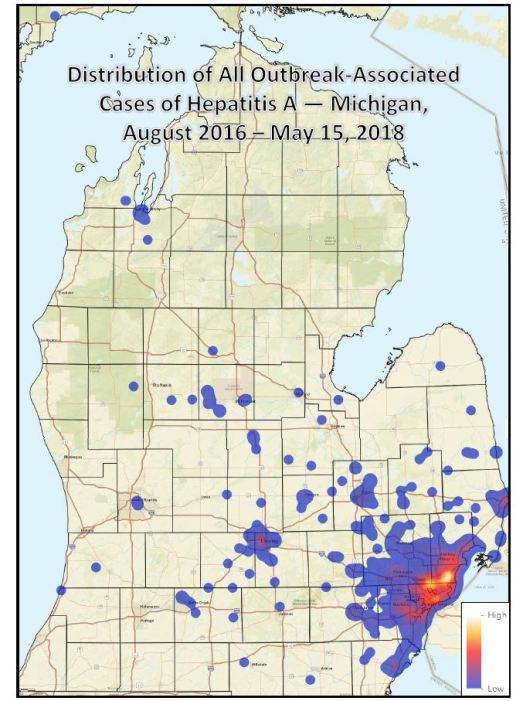What You Need to Know About the Ongoing Hepatitis A Outbreak in Michigan
July 24, 2018
Categories: Infectious Disease
Hepatitis A virus (HAV) is a serious, highly contagious liver disease. Fortunately, it is vaccine-preventable, and the vaccine has been part of the routine childhood vaccinations since the late 1990s. But the U.S. population was ripe for a HAV outbreak, given the large number of unvaccinated adults, and Michigan is home to the largest ongoing outbreak. In this Q&A, Anurag Malani, MD, Medical Director, Infection Prevention and Control Services, St. Joseph Mercy Ann Arbor, Chelsea and Livingston, addresses who is at the greatest risk for HAV, and the most effective means of prevention.
-
-
What is Hepatitis A virus?
Hepatitis A virus (HAV) is a serious, highly contagious liver disease. After exposure, the average time to infection is four weeks, and patients can be transmissible for weeks. Historically, transmission was most common from child (often asymptomatic) to adult through the fecal-oral route, however the advent of effective vaccine has changed this epidemiology. The likelihood of symptomatic illness is directly related to age, and adults are generally symptomatic. There are several ongoing outbreaks in different states, the largest taking place in Michigan.
-
What are the symptoms of HAV?
Symptoms are often non-specific, including fever, fatigue, nausea, loss of appetite, yellowing of the skin and eyes (jaundice), dark urine, abdominal pain, joint pain.
-
How large is the outbreak in Michigan, and who is most at risk for HAV?Since August 2016, there have been 859 cases of HAV associated with the Michigan outbreak. There have only been a few associated pediatric cases, underscoring the effectiveness of routine childhood vaccination.
There are several unique features of the current outbreak – history of injection/non-injection drug use, homelessness, and men who have sex with men (MSM) are at greater risk. Transmission appears to be through direct person-to-person spread and illicit drug use; not blood borne but likely attributed to hygiene-related issues via the fecal-oral route.
Notably, this outbreak has had an extremely high hospitalization rate (80%) with significant morbidity and mortality (27 deaths, 3.1%). Of the reported 859 cases, 395 (51%) have a documented substance use disorder, 205 (27%) have coinfection with hepatitis C, 76 (15%) are MSM, and 106 (14%) are homeless or transient living. There have also been secondary clusters among healthcare workers (HCW) through occupational exposure.
-
What is the best method of prevention for HAV?
The most effective strategy for HAV prevention is vaccination. While the HAV is recommended as a part of the routine childhood vaccination schedule, most adults have not been vaccinated and thus, may be susceptible to the hepatitis A virus. Since the outbreak began, more than 140,000 vaccinations have been given in Michigan. Many health systems – including Saint Joseph Mercy Health System – have also recommended and provided vaccination to their health care workers. Vaccination is given in two doses. Another important recommendation for prevention is to wash your hands after going to the bathroom and before preparing meals for yourself and others.One successful strategy used during the recent San Diego outbreak was targeted emergency department vaccination. Michigan has also taken a similar statewide strategy, and the EDs at St. Joseph Mercy Ann Arbor and Livingston have begun high-risk screening and providing the vaccine to these groups. The CDC projects the HAV outbreak in Michigan to continue for at least the next year.

Figure courtesy of Michigan Department of Health and Human Services.
-
What is Hepatitis A virus?



